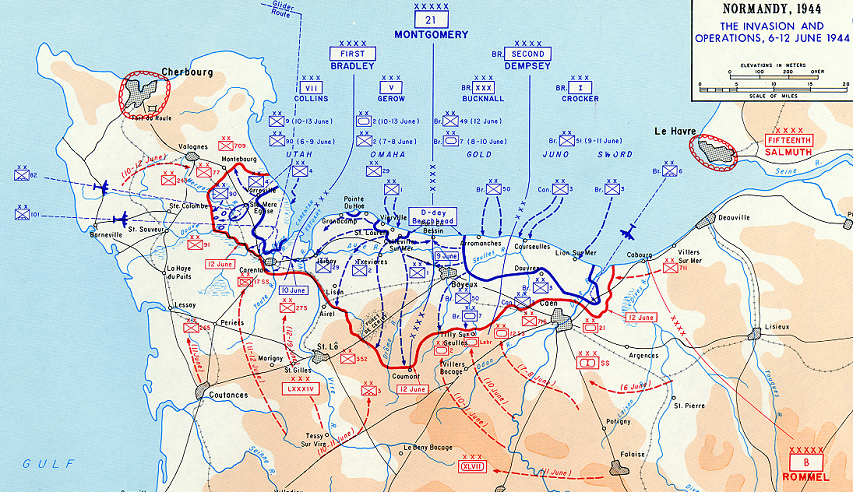![]() My weekly Guild Wars 2 community round-up at GuildMag is now online. The Festival of the Four Winds continues (and will run through the rest of the month). ArenaNet announced that Living Story Season Two will be permanent content, and that they’re hoping to also eventually make the Season One content available through the new Living Story Journal. Season Two debuts on July 1st. In addition, there’s the usual assortment of blog posts, videos, podcasts, and fan fiction from around the GW2 community.
My weekly Guild Wars 2 community round-up at GuildMag is now online. The Festival of the Four Winds continues (and will run through the rest of the month). ArenaNet announced that Living Story Season Two will be permanent content, and that they’re hoping to also eventually make the Season One content available through the new Living Story Journal. Season Two debuts on July 1st. In addition, there’s the usual assortment of blog posts, videos, podcasts, and fan fiction from around the GW2 community.
June 6, 2014
This week in Guild Wars 2
1st Canadian Parachute Battalion War Diary
Excerpt from 6 June, 1944:
6th June 1944
Place: Carter Bks, Bulford
The initial stages of operation OVERLORD insofar as the 1st. Cdn. Parachute Battalion was concerned, were divided into three tasks. The protection of the left flank of the 9th Para Battalion in its approach march and attack on the MERVILLE battery 1577 was assigned to “A” Company. The blowing of two bridges over the RIVER DIVES at 1872 and 1972 and the holding of feature ROBEHOMME 1873 was assigned to “B” Company with under command one section of 3 Para Sqdn Engineers. The destruction of a German Signal Exchange 1675 and the destruction of bridge 186759 plus neutralization of enemy positions at VARRAVILLE 1875 was assigned to “C” Company.
The Battalion was to drop on a DZ 1775 in the early hours of D Day, “C” Company dropping thirty minutes before the remainder of the Battalion to neutralize any opposition on the DZ. The Battalion emplaned at Down Ampney Airfield at 2250 hours on the 5th June, 1944. “C” Company travelled in Albemarles and the remainder of the Battalion in Dakotas (C-47). The flight was uneventful until reaching the French coast when a certain amount of A.A. fire was encountered. Upon crossing the coast-line numerous fires could be seen which had been started by the R.A.F. bombers. Unfortunately the Battalion was dropped over a wide area, some sticks landing several miles from their appointed R.V.. This factor complicated matters but did not deter the Battalion from securing its first objectives.
Protection of Left Flank of 9 Para Bn – A Company
“A” Company was dropped at approximately 0100 hours on the morning of 6th June, 1944. Lieut. Clancy, upon reaching the Company R.V. found only two or three men of the Company present. After waiting for further members, unsuccessfully, of the Company to appear, he decided to recce the village of GONNEVILLE SUR-MERVILLE 1676. Taking two men he proceeded and penetrated the village but could find no sign of the enemy. He then returned to the Company R.V. which he reached at approximately 0600 hours and found one other Officer and twenty Other Ranks of the Battalion and several men from other Brigade Units waiting. The entire body then moved off along the pre-arranged route to the MERVILLE battery. Encountering no other opposition enroute other than heavy R.A.F. Bombardment at GONNEVILLE SUR-MERVILLE. Upon completion of the 9th Battalion task the Canadian party acted first as a recce patrol to clear a chateau 1576 from which a German M.G. had been firing and then acted as a rear guard for the 9th Battalion withdrawal toward LE PLEIN 1375. The party left the battalion area (9th Battalion) at LE PLEIN at 0900 hours and reached the 1st Cdn. Para. Bn. position at LE MESNIL BAVENT cross roads 139729 at 1530 hours on the 6th June, 1944.ROBEHOMME – “B Company
Two platoons of “B” Company were dropped in the marshy ground south and west of ROBEHOMME. Elements of these platoons under Sgt. OUTHWAITE then proceeded toward the Company objective. Enroute they encountered Lieut. TOSELAND with other members of “B” Company making a total of thirty All Ranks. They were guided through the marshes and enemy minefields to the ROBEHOMME bridge by a French Woman. On arriving at the bridge they met Capt. D. GRIFFIN and a further thirty men from various sub-units of the Battalion, including mortars and vickers Platoons. MAJOR FULLER who had been there for some time left in an attempt to locate Battalion Headquarters. Capt. GRIFFIN waited until 0630 hours for the R.E.’s who were to blow the bridge. As they failed to arrive explosives were collected from the men and the bridge successfully demolished.
A guard was left on the bridge and the main body withdrawn to the ROBEHOMME hill. Although there were no enemy in the village there were several skirmishes with enemy patrols who were attempting to infiltrate through the village and some casualties were suffered by the Company. An O.P. was set up in the church spire. An excellent view was obtained of the road from PONT DE VACAVILLE 2276 to VARRAVILLE. Artillery and infantry could be seen moving for many hours along this road from the East. It was particularly unfortunate that wireless communication could not be made with Bn. H.Q. as the subsequent fighting of the Battalion was carried out in such close country that observation of enemy movement was almost impossible.
At 1200 hours on the 7th June, 1944, it was decided to recce the route to Bn. H.Q.. Upon the route being reported clear orders were issued for the party to prepare to join Bn. H.Q. Lieut. I. WILSON, Bn. I.O. came from LE MESNIL to guide the party back. The move was made at 2330 hours, the strength of the party by this time being 150 All Ranks, the addition having been made by stragglers of various units who had reported in. The wounded were carried in a civilian car given by the cure, and a horse and cart given by a farmer. The route was BRIQUEVILLE 1872 to BAVENT road 169729, through the BOIS DE BAVENT and on to LE MESNIL cross roads. Near BRIQUEVILLE the lead platoon was challenged by enemy sentries. The platoon opened fire killing seven and taking one prisoner. Shortly afterwards this same platoon was fortunate enough to ambush a German car which was proceeding along the road from BAVENT. Four German Officers were killed. Bn. Headquarters was reached at 0330 hours on the 8th June, 1944.
VARRAVILLE – “C” Company
The majority of “C” Company was dropped west of the RIVER DIVES, although some sticks were dropped a considerable distance away including one which landed west of the RIVER ORNE. Due to this confusion the company did not meet at the R.V. as pre-arranged but went into the assault on the Chateau and VARRAVILLE in separate parties. MAJOR McLEOD collected a Sgt. and seven O.R.’s and proceeded towards VARAVILLE. En route they were joined by a party under Lieut. WALKER. One of the Sgts. was ordered to take his platoon to take up defensive positions around the bridge that the R.E. sections were preparing to blow. This was done and the bridge was successfully demolished.
MAJOR McLEOD and Lieut. WALKER with the balance of the party then cleared the chateau and at the same time other personnel of “C” Company arrived from the DZ and cleared the gatehouse of the chateau. The gatehouse then came under heavy M.G. and mortar fire from the pill box situated in the grounds of the chateau. The pill-box also had a 75 mm A/Tk. Gun. The whole position was surrounded by wire, mines and weapon pits. MAJOR McLEOD, Lieut. WALKER and five O.R.’s went to the top floor of the gatehouse to fire on the pillbox with a P.I.A.T. the enemy 75mm A/Tk. Gun returned fire and the shot detonated the P.I.A.T. ammunition. Lieut. WALKER, CPL. OIKLE, PTES. JOWETT and NUFIELD were killed and MAJOR McLEOD and PTE. BISMUKA fatally wounded. PTES. DOCKER and SYLVESTER evacuated these casualties under heavy fire. CAPT. HANSON, 2 i/c of “C” Company was slightly wounded and his batman killed while proceeding to report to the Brigade Commander who had arrived in the village from the area in which he dropped. “C” Company, together with elements of Brigade H.Q. and the R.E.’s took up defensive positions around the village and a further party encircled the pill-box in order to contain the enemy. A further party of “C” Company under Lieut. McGOWAN who had been dropped some distance from the DZ arrived in VARAVILLE in time to catch two German Infantry Sections who were attempting to enter the town. Lieut. McGOWAN’s platoon opened fire causing casualties and the remainder of the enemy surrendered. This platoon took up firing positions firing on the enemy pill-box. “C” Company H.Q. which was located in the church yard pinned an enemy section attempting to advance in a bomb crater killing at least three. The chateau was evacuated by our troops and left as a dressing station. An enemy patrol re-entered the chateau and captured the wounded including Capt. BREBNER, the Unit M.O., and C.S.M. Blair of “B” Company. This patrol although attacked by our own troops managed to escape with their prisoners.
Heavy enemy Mortar Fire and sniping was brought to bear on our positions from the woods surrounding VARAVILLE. During this time the local inhabitants were of great assistance, the women dressing wounds and the men offering assistance in any way. One Frenchman in particular distinguished himself. Upon being given a red beret and a rifle he killed three German Snipers. This man subsequently guided the Brigade Commander and his party towards LE MESNIL. Although it is believed he was a casualty of the bombing attack that caught this party enroute to LE MESNIL.
At approximately 1030 hours the enemy pill-box surrendered. Forty-two (42) prisoners were taken and four of our own men who had been captured were released. From 1230 hours on artillery fire was brought to bear on VARAVILLE from the high ground east of the RIVER DIVES. At 1500 hours cycle troops of the 6th Commando arrived and at 1730 hours on 6 June, 1944, “C” Company proceeded to the Bn. area at LE MESNIL. The german prisoners giving evident satisfaction to the French population enroute.
VICKERS PLATOON – Initial Stages
The Vickers platoon was dropped in four sticks of ten or eleven each being a total of forty-one (41) All Ranks. For the first time their M.G.’s were carried in Kit Bags, a number of which tore away and were lost.
The Platoon was dropped over a wide area, a part of them joining “C” Company’s attack on VARAVILLE, part joining “B” Company at ROBEHOMME and part joining Bn. H.Q.. Casualties on the drop totalled twelve missing and three wounded. One of the missing, PTE. PHIPPS, was identified in a photo in a German newspaper found on a P.W. After the initial Company tasks had been accomplished the platoon was deployed to the Companies as single gun detachments or as Sections.
MORTAR PLATOON – Initial Stages
The Mortar Platoon was dropped over a wide area and suffered very heavy loss in equipment due to kit bags breaking away and a great majority of the men landing in marshy ground. As the platoon dropped they attached themselves to the nearest company they could find and assisted in the capture of the objectives. One detachment commander landed on top of the German pill-box at VARAVILLE. He was made prisoner and spent the rest of the time in the pill-box until the Germans surrendered to “C” Company. A point of interest was that the P.I.A.T. Bombs did definite damage to the interior of the pill-box and had a very towering effect upon the morale of the defenders.
Some of the Mortar Platoon which joined “B” Company at ROBEHOMME were detailed to guard the approaches to the destroyed bridge. Three enemy lorries full of infantry appeared on the other side of the bridge. The guard opened fire knocking out one truck killing most of its occupants. The other two lorries were able to withdraw. One of our own men who was a prisoner in the lorry was able to make good his escape.
Upon the detachments arriving at LE MESNIL they were re-grouped as a platoon and given three mortars which had arrived by sea. These mortars were set up in position in the brickworks where they engaged the enemy.
BATTALION HEADQUARTERS – Initial Stages
The Commanding Officer, 2 i/c, Signals Officer and the Intelligence Officer and a small portion of the Battalion Headquarters together with elements of 224 Para Fd. Ambulance and other Brigade Units met at the Battalion R.V. in the early hours of the morning of 6th June, 1944. The Signals Officer was detailed to look after the Enemy Signal Exchange near the R.V.. He went into the house and found a certain amount of Signals equipment which he destroyed but he found no Germans. The Intelligence Officer set out with two men to recce VARAVILLE and bring back a report on the situation. In the Battalion Headquarters meantime the party moved off to LE MESNIL taking with them many scattered elements including a 6 Pdr. A/Tk. Gun and crew. Upon reaching the Chateau 1574 they encountered part of the Brigade Headquarters. The party there upon split up into unit parties and continued until they reached the orchards 141729 where they came under heavy sniping fire from nearby houses. This fire caused several casualties including one Officer. The enemy were forced to withdraw from the buildings after an attack by the party. The party reached the Battalion area at approximately 1100 hours on 6th June, 1944.
H/T to @LCMSDS for the link.
Update: War diaries for units in the 3rd Canadian Division in Normandy can be read here.
“Fizzy dishwater” instead of Champagne for the “wine Fuhrer”
Chris Mercer on the various ways the French Champagne producers tried to keep their best wine from being diverted to the use of the Nazis:
By the time the French city of Reims was liberated in August 1944, many Champagne houses and growers had spent four years playing a game of high stakes cat-and-mouse with the local Nazi ‘wine fuhrer’, Otto Klaebisch.
As Julian Hitner writes in a feature published in the July issue of Decanter magazine, it was Klaebisch’s job to keep the Nazi empire topped up with France’s finest Champagnes. At its peak, Klaebisch was demanding 400,000 bottles per week.
In response, many Champenois resorted to subterfuge to try to protect their most precious vintages and cuvees.
As noted in the book Wine & War by Don & Petrie Kladstrup, some built fake walls in their cellar to hide their best stocks, while others intentionally mislabelled bottles.
On more than one occasion, Klaebisch suspected he was being duped. ‘How dare you send us fizzy dishwater?’ he asked 20-year-old Francois Taittinger.
‘Who cares? It’s not as if it’s going to be drunk by anyone who knows anything about Champagne,’ replied the young Taittinger, who was subsequently thrown in prison for several days.
H/T to Brendan for the link.
Mulberries, PLUTO and Hobart’s Funnies
Seventy years ago today, the Allies launched Operation Overlord, the invasion of Normandy by the combined British, American, and Canadian armies. A huge fleet of combat and transport vessels, supported by a large proportion of the United States Army Air Force and the Royal Air Force bomber and fighter aircraft were all deeply involved in making the invasion a success. In addition, perhaps the world’s largest disinformation campaign was being run to keep the German high command unsure of the real time and location of the invasion: the Pas de Calais and the Norwegian coast were also potential invasion targets, forcing the defenders to spread their forces thinner and to keep as many as possible out of reach of the real beaches.
In addition to the operational uncertainty of where to expect the blow, the Germans were also split about how best to conduct the defence: Field Marshal Rommel wanted to rush units to the beach as soon as possible, to defeat the Allies before they got inland. General Geyr von Schweppenburg, commander of Panzer Group West (and Field Marshal von Rundstedt, overall commander in the West), on the other hand, preferred to meet the Allies further inland (not taking the full impact of Allied air superiority into account). On 6 June, the defenders fell between the two philosophies, not being able to mass enough force to stop the invaders in their tracks, but suffering higher casualties in the attempt to move units toward the coast in the teeth of RAF/USAAF attacks.
The invasion beaches were code-named Utah (4th US Division), Omaha (1st and 29th US divisions), Gold (50th British Division), Juno (3rd Canadian Division), and Sword (3rd British Division). Before the amphibious forces landed, three paratroop divisions were dropped behind the beaches to slow down German response (US 82nd and 101st Airborne Divisions to the West and Southwest of Utah beach, and the 6th British Airborne to the East of Sword beach).
One thing to note from the map is that there wasn’t a significant port within the invasion zone: the Allies had learned the bitter lessons of attacking a port in August of 1942 and the 2nd Canadian Division had paid in blood for the tuition. This meant a way had to be found to keep getting supplies to the troops after they moved off the beaches, until a functioning port could be secured. The Allied answer was to bring a port with them from England — two of them, actually — one to support the US forces in the West and one to support the British and Canadian forces in the East. These were the Mulberry harbours:
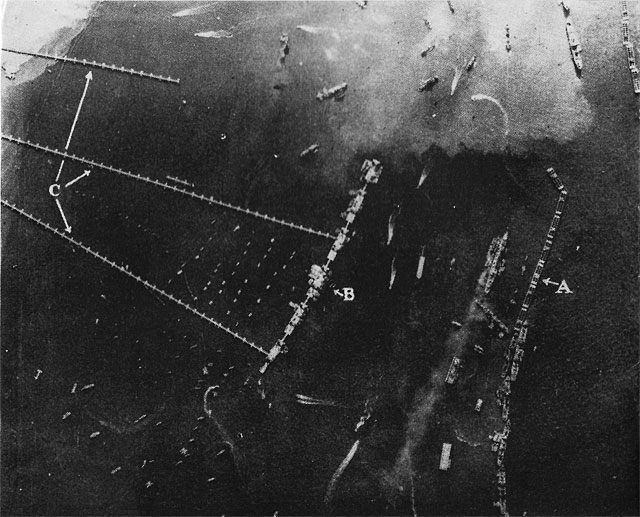
Think Defence explains how the Mulberry harbour worked:
In the image above these three components are shown.
A; Breakwater to attenuate waves
B; Pier heads at which to load and unload
C; Causeways that connected the pier heads to the beach
Each of the components was given a code word but fundamentally, they were concerned with either providing sheltered water or connecting ships and the beach.
There have been a number of different theories about how the Mulberry name was chosen, the more fanciful ones being completely incorrect.
Brigadier White recalls the moment he received a memo, unclassified, with the heading ‘Artificial Harbours’ and after recovering from the shock of such poor security immediately consulted with the Head of Security at the War Office. The next code, from the big book of code words, was Mulberry, it was that simple.
[…]
There were two complete Mulberry harbours, A for American and B for British, each the size of Dover harbour. Once the task of constructed and assembling the components on the South coast of England was complete they were ordered to Normandy on the 6th of June 1944, D-Day, departing on the 7th
Assembling the components was an effort in itself, requiring 600 tugs drawn from all parts of the UK and USA, all under the supervision of the Admiralty Towing Section commanded by Rear Admiral Brind.
Operational security was paramount, the captains of the block ships were told they were going to the Bay of Biscay and a model of the Mulberry harbour and invasion beaches in the headquarters of the Automobile Association at Fanum House was made by toymakers who were confined to the building until well after the invasion.
Unfortunately, the Western harbour was severely damaged in a storm a few weeks after coming into service, so the Eastern Mulberry had to do double duty after that.
Aside from the need to get reinforcements, rations, ammunition and other supplies forward, the Allied armies were highly motorized, and required vast amounts of fuel. Without a port’s specialized unloading facilities, it was assumed that it would be somewhere between difficult and impossible to keep the armies mobile. To address this, PLUTO was developed: Pipe Line Under The Ocean.
A great solution, although as Think Defence points out, it didn’t actually go into service until a few months after D-Day, and was not quite the war-winner the newsreel portrayed:
Second in daring only to the artificial harbors project and provided our main supplies of fuel during the Winter and Spring campaigns.
What also PLUTO did was allow vital tanker tonnage to be deployed to the Far East theatre.
Despite the understandable over exaggeration of the success of PLUTO it should be noted that fuel did not start flowing until September 1944, well after the invasion and on the 4th of October, BAMBI was closed down and operations concentrated on DUMBO after it had delivered a measly 3,300 tonnes, hardly war winning.
Cherbourg was by then receiving tanker supplies direct from the USA.
 Getting across the channel was a major undertaking, but getting the troops ashore with enough firepower to break out of the beach defences required more innovation. The British army established a specialized unit to develop and operate vehicles and weapon systems specifically designed for that purpose. Major General Sir Percy Hobart was the commander of the 79th Armoured Division, and he was exactly the right man for the job (being related by marriage to Montgomery may have helped, too, but before taking command he was acting as a corporal in the Home Guard).
Getting across the channel was a major undertaking, but getting the troops ashore with enough firepower to break out of the beach defences required more innovation. The British army established a specialized unit to develop and operate vehicles and weapon systems specifically designed for that purpose. Major General Sir Percy Hobart was the commander of the 79th Armoured Division, and he was exactly the right man for the job (being related by marriage to Montgomery may have helped, too, but before taking command he was acting as a corporal in the Home Guard).
Hobart’s unit developed some of the most interesting armoured vehicles (not all of which were brilliant successes) and it’s safe to say that the Allies would have suffered much higher casualties without Hobart’s “Funnies”. In fact, General Eisenhower said as much himself: “Apart from the factor of tactical surprise, the comparatively light casualties which we sustained on all beaches, except OMAHA, were in large measure due to the success of the novel mechanical contrivances which we employed, and to the staggering moral and material effect of the mass of armor landed in the leading waves of the assault. It is doubtful if the assault forces could have firmly established themselves without the assistance of these weapons.” Think Defence has a good summary of many of these odd and interesting vehicles:
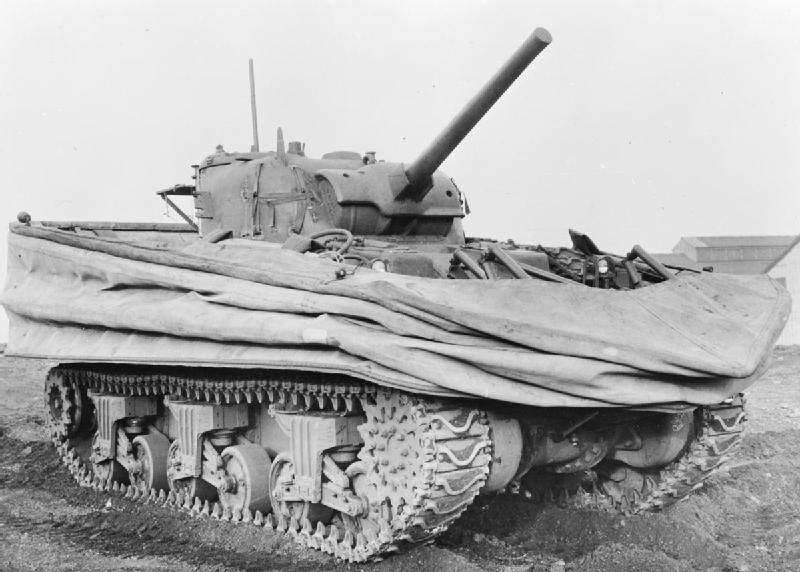
Sherman tanks were also converted into amphibious vehicles by the addition of a canvas skirt, propellers and other modifications. These provided vital armoured fire support in the opening phase of the beach assault although a number were lost to the heavy seas when they were launched too far from the beach. It is widely thought that as these losses were particularly heavy on Omaha beach it was this that contributed to the very high losses in that area.
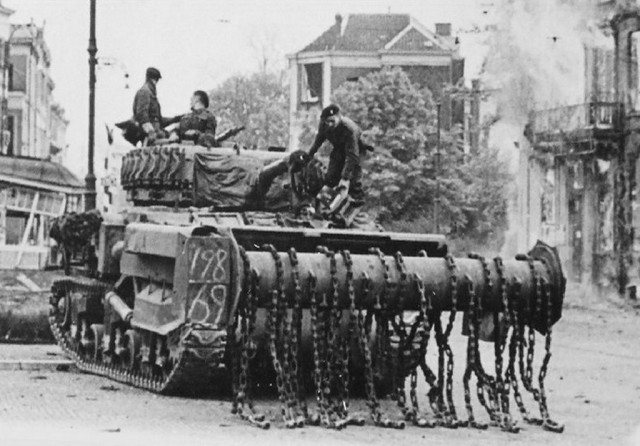
Mine clearance was carried out by a number of means but the preferred method was to use rotating chain flails to detonate the mines thus clearing a path the width of the tank. The flails were mounted on the front of the tank and were called Sherman Crabs. A number of Churchill based designs using rollers and ploughs were also employed, although this image shows one mounted on a Sherman.
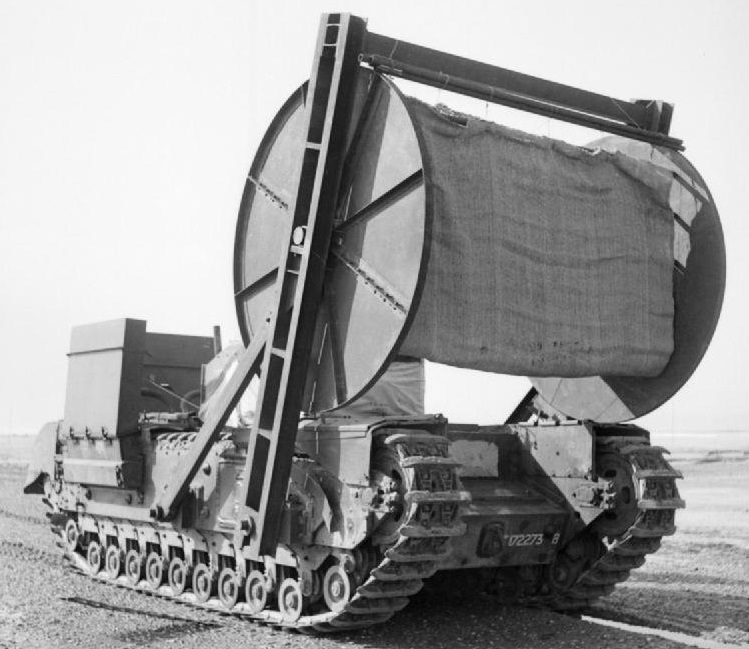
The beach surveys had revealed the existence of large patches of clay that would not bear the weight of heavy vehicles and artillery. To overcome this the ‘bobbin’ tanks were used that laid a continuous reinforced canvas mat over the soft ground, thus spreading the load over a wider area.
Canadian paratroopers on D-Day – “he thought we were battle hardened and we were as green as green could be”
Lance Corporal John Ross tells the Ottawa Citizen about his D-Day experiences with the 1st Canadian Parachute Battalion:
“We attacked the strong point; there was an all-night fire fight. We had casualties and the Germans did too. At about 10 o’clock in the morning they surrendered. There were about 30 of us there, 42 Germans surrendered to us. They outnumbered us and they out gunned us,” describes Capt (Ret) John Ross, now 93 years-old recalling his time as a paratrooper who dropped several kilometers inland of Normandy on D-Day.
“We took off on the 5th of June, one day before D-Day. C Company was given the job to go in 30 minutes ahead to clear the drop zone of any enemy and attack the German complex.”
Capt (Ret) Ross served as a Lance Corporal in C Company, 1st Canadian Parachute Battalion, 3rd Airborne Brigade, 6th British Airborne Division. He was dropped from an Armstrong Whitworth Albemarle, a small two engine paratroop transport aircraft.
[…]
When thinking back to his time in Normandy Capt (ret) Ross remembers how Canadian soldiers were thought of as, seasoned warriors.
“I read an excerpt written by a German General after the war. He was in that area that we dropped in and he said that the reason they were overcome was because they faced battle hardened Canadians. I’d like to write a letter to him and say none of those Canadians had ever heard a shot fired in anger; he thought we were battle hardened and we were as green as green could be.”


